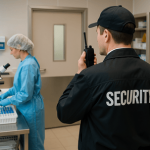
Municipal buildings play a unique role in society—they must be both open and secure. From city hall to public libraries and recreation centers, these spaces welcome residents from all walks of life. At the same time, they house sensitive information, public officials, and critical infrastructure. That creates a challenge: how do you protect public buildings without making them feel like fortresses?
The answer lies in subtle, layered security. Today’s modern access control systems, surveillance cameras, and intrusion detection technologies can be implemented in ways that are nearly invisible to the public—but highly effective behind the scenes.
In this article, we’ll explore how government facility security systems can create a safe environment while still fostering trust, transparency, and a welcoming civic atmosphere.
l
l
Why Visibility Isn’t Always the Goal
Visible security—metal detectors, uniformed guards, bulky cameras—can provide reassurance, but in some settings, it creates unintended consequences. Visitors may feel uncomfortable or intimidated, especially in community spaces like permit offices, municipal courts, or public service departments.
That’s where “soft” security design comes into play. It’s about incorporating protection into the fabric of the building: using discreet cameras, integrated badge systems, and architectural design to guide behavior without confrontation.
l
l
4 Ways to Implement Subtle Security in City Buildings
1. Discreet Surveillance Placement
Modern surveillance cameras are smaller, sleeker, and easier to conceal than ever before. Dome cameras can be integrated into ceiling tiles or recessed into soffits, offering wide-angle views without being intrusive. Pan-tilt-zoom (PTZ) systems allow for broad monitoring from a central location, minimizing the number of visible devices.
Key benefit: You maintain public building surveillance coverage without overwhelming visitors with cameras at every turn.
l
l
2. Architectural Access Control
Access control doesn’t need to involve clunky card readers bolted to walls. Many municipalities are adopting aesthetic-friendly readers built into door frames, turnstiles, or reception counters. With mobile credentials, authorized staff can tap their phone or badge on subtle, low-profile readers to move between zones.
Key benefit: Security works in the background—staff are protected, but the public experiences smooth, open flow.
l
l
3. Zone-Based Protection Without Physical Barriers
Instead of locking down entire floors or buildings, municipalities are embracing zone-based access control. Public areas remain open, while administrative, financial, or IT spaces require additional clearance. Interior doors look like standard hallway doors, but they’re secured with silent electronic locks that track access attempts.
Key benefit: Citizens feel like the building is accessible, while sensitive departments stay protected.
l
l
4. Subtle Signage and Environmental Cues
Security doesn’t always mean hardware. Simple environmental cues—like clear wayfinding signage, staff presence, or “authorized personnel only” doors—can discourage wandering or loitering without confrontation. Some cities even use decorative barriers (planters, furniture, glass walls) to guide flow and discourage unauthorized access.
Key benefit: Encourages self-policing and order without the need for visible enforcement.
l
l
Why This Matters Now
In 2025, cities are under increasing pressure to modernize facilities, improve public safety, and maintain community trust. That’s a delicate balance. By designing secure access control for city buildings in a way that supports civic openness, municipalities can reduce risk, improve operations, and better serve their communities.
Security shouldn’t feel like surveillance—it should feel like confidence.
l
l
SSP’s Approach to Civic-Focused Security
At SSP, we specialize in helping municipalities deploy government facility security systems that blend into the background—but deliver strong protection when it matters most. From site audits to custom system design, we help public agencies build layered, intuitive security that supports both people and operations.
l
l
Let’s protect your buildings—without compromising your mission
Contact us today to schedule a walkthrough or facility risk assessment.


